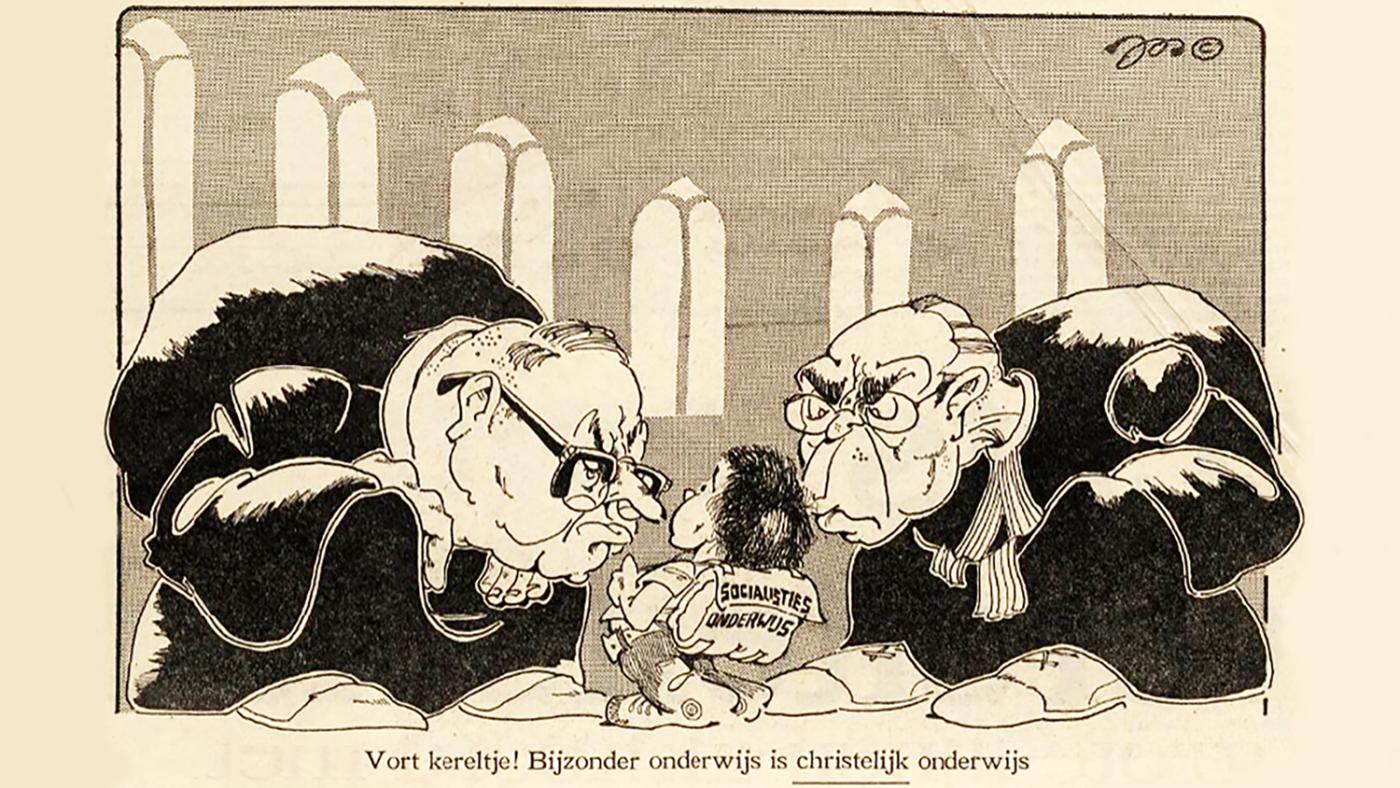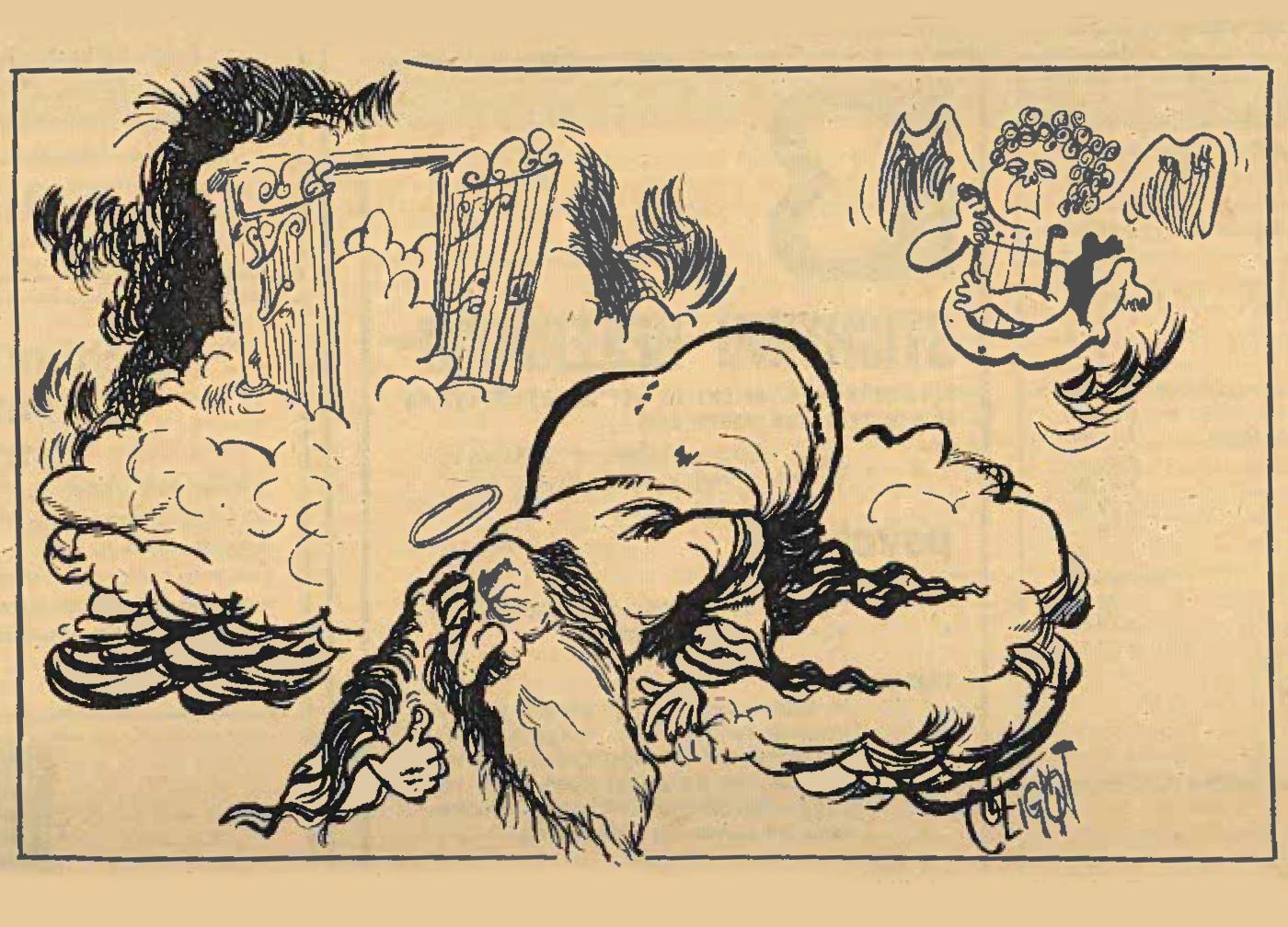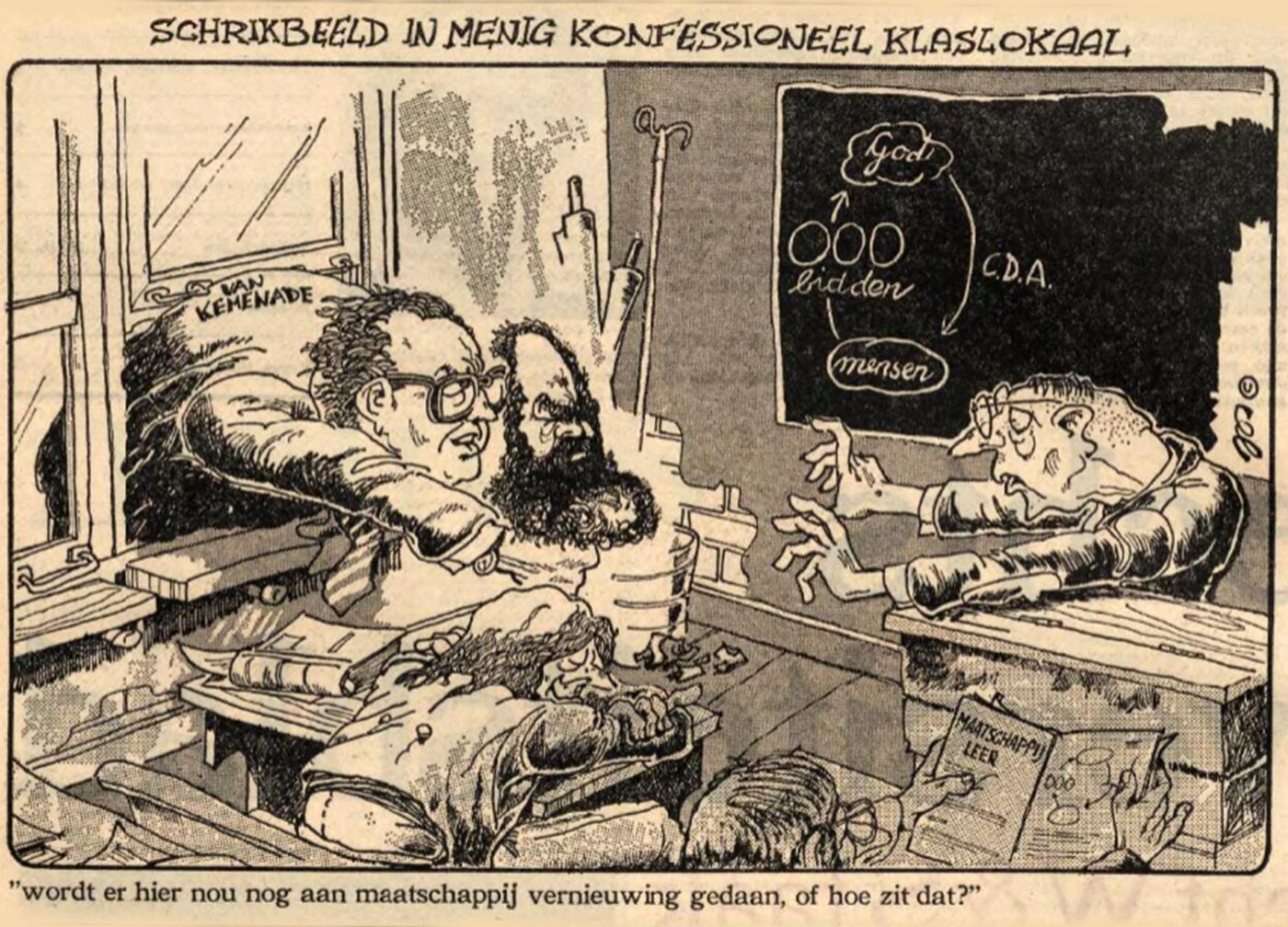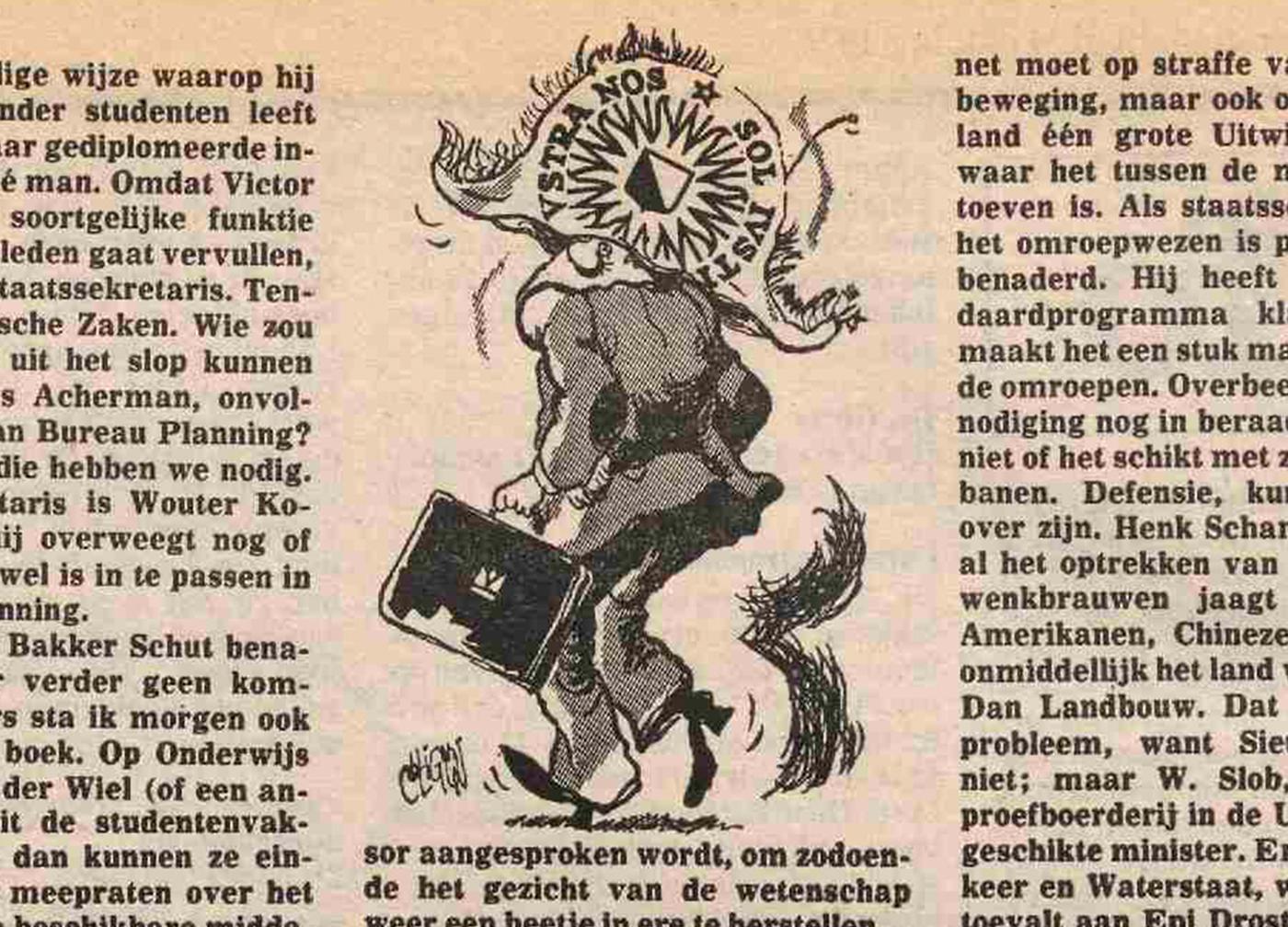Former U-blad cartoonist Jos Collignon exhibits at University Library
'Disagreeing with the editors made me a Nato warmonger'

The greeting is warm and heartfelt, and it’s clear that Jos Collignon has fond memories of the time when the editorial office of U-Blad was still housed in the cramped attic of the former residence of Dutch theologian and writer Nicolaas Beets (Boothstraat 6), which back then also housed the Communications Department which had three employees only. His arrival at U-Blad was due to a curious coincidence.
"As a gift for one of their wedding anniversaries, I had drawn a picture of my parents. I showed it to a friend of mine, whose sister was married to Willem Kuipers, who had just become editor-in-chief of U-Blad. Willem was very ambitious. Deep down, he actually wanted to turn U-Blad into a daily, a genuine Utrecht quality newspaper, and of course that included a cartoonist. When he saw my drawing, he asked if I wanted to join him and draw for the university magazine. I was busy with my law degree, and doing that in addition to my study seemed like fun."

Cartoon about the Orthodox Reformed church
A communist stronghold
Jos still has vivid memories of those early days, which oozed the atmosphere of the 1970s. "At the time, U-Blad was your typical communist stronghold. But what can you expect? Almost all the guys working there came from the student magazine Troof, a real hotbed of Marxism. There were people on the editorial board who were much more astute than I was. Their tongues were razor-sharp, and they always wanted to debate. That scared me a bit at first. I sometimes tried to argue, but if I didn't agree with them, they instantly called me a Nato warmonger.”
"They were romantics, too, by the way. I remember going to see the film Novecento with Hans van Laarhoven, editor-in-chief at U-Blad. At the time, the movie was a big hit about the class struggle in rural Italy. You know the kind: men and women singing battle anthems as they attacked those in power with pitchforks. We came out of the cinema and Hans really had that dreamy look in his eyes. 'What did you think of it', he asked. 'Oh', I said, ‘not a bad flick.’ But he just sighed: ‘amazing’."
Charming right-winger Charles Groenhuijsen
Although the editorial office was quite left-wing, there was also a very tolerant vibe, according to Collignon. "This is evidenced by the fact that a little later, Charles Groenhuijsen was hired. Compared to the rest of the team, Groenhuijsen was already pretty right-wing back then, but they saw he had talent. He wrote quickly, and he produced good articles.” Nowadays Groenhuijsen is a famous journalist in the Netherlands.
“I have a fun story about working with him. In those early days, I also wrote the occasional article for U-Blad. One time, we went to The Hague together to report on what the political parties thought of the cuts in higher education. We visited all the parties except for CPN, the communist party, because Charles thought that was nonsense. ‘They always say the same rubbish’, he said, ‘we won't include them’. When we showed the story to the editors, those left-wing guys said: 'You can’t do this. The only party that has a totally different and better story is the CPN and you’ve left them out'. They demanded that we go back to talk to someone from the CPN as well. So, after some protest, we went back to The Hague, and we were received in a dark, dingy little room by a very scary man – a real commie. He was giving us the evil eye, and – true to form – he was spinning the story as expected. In the end, we wrote it down, but after that conversation, I knew for sure: you shouldn't want anything to do with communists."

Jos Collignon (sitting on the left) with other editors of U-blad. The photo was made as a going away gift for Charles Groenhuijsen.
All fear
In terms of journalism, Collignon's contribution was limited to a handful of pieces, but his portfolio of drawings kept growing. It became noticeable that his work very rarely featured higher education, or Utrecht University. He laughs. "They hired me to make caricatures of university bigwigs, but in the end, not much of that came of that because I figured: if my future lies in drawing, I should draw more about social themes; that way, I would stand out. The university didn't really interest me either. For instance, I never went to the university council, and I had no idea who the university president was. For me, U-Blad was a springboard for national journalism, a great opportunity to hone in on your skills, and the editors were fine with that."
We look at some cartoons from Jos’ early days, and what he sees doesn’t fill him with great joy. "Absolute beginner's work. Based on these drawings, I would never have hired myself. Just look at all those lines that are running in perfect parallel: that's all fear. I was too afraid to colour outside the lines. This drawing, with Minister of education Van Kemenade looking in through the window, is already a bit more professional, but most of it from that time is amateurish. But that was the great thing about U-Blad: they gave you a shot. They didn't kick me out right after those first drawings."

Cartoon minister of eduction van Kemenade
A long tirade
Incidentally, anyone who thinks that Jos Collignon in his early U-Blad days was not yet the critical cartoonist he would later become, is mistaken. Even in his earliest drawings, the church had to be denounced, as well as – incidentally – Israel’s colonial policy, in his view. He points to War Trauma, a drawing he made during the autumn of 1975. "This drawing in particular caused quite a stir, because it was critical of Israel and, at the time, this was absolutely unacceptable. The United Nations had passed a resolution condemning Israeli land grabbing, much to the fury of the global Israel lobby. The UN is that little man in the drawing pulling out the flag For Jews only, and the protesting heads are the lobbyists.
At the time, Bert Kieboom was editor-in-chief of U-Blad. Kieboom was a very liberal man who thought everything should be allowed, including this drawing. But he did say: 'Jos, there will be trouble from this'. Well, he was right, because it turned into a riot. One professor even demanded that I come to his office to explain myself. Bert said: 'Will you please go and meet him? I'm in so much trouble with those people already.’ Of course I wanted to. I still thought he really wanted an explanation. After all, I was studying international law, so I figured I could tell him a thing or two. But that was terribly naive of me because I didn't get the chance to say anything at all. One long tirade came over me. He went on such a terrible rant that, at one point, I just walked away."

Cartoon war trauma
A hussar
The end of Jos Collignon's career at U-Blad came as unexpectedly as the start. "One day, I was at the editorial office when national newspaper NRC called. I happened to pick up the editorial phone because we all did that when it was convenient. It was journalist Ton Elias. He asked for the number of Frits Müller, then the main cartoonist at U-Blad. I didn't have his number, but I said, ‘I wouldn’t mind doing something for you'. ‘Sure, but', he said, 'we don't know you'. 'Well,', I said, ‘do you have the U-Blad in front of you? On this and that page you can see one of my drawings.' He looked at it and then he said: 'I'll have a word with the editor-in-chief'. Fifteen minutes later, he called back and said: 'We would like to give you a try.'
They wanted a drawing of Van Kemenade as a hussar jumping with his horse over a whole pile of comments on the Policy Outline Memorandum. But he added: 'Remember to draw that hussar properly, because we have quite a few professional soldiers among our readers, and they will definitely resent us if the hussar isn’t accurate in your drawing'. I was living in a squat on Wolter Heukelslaan at the time, and on my way home, I picked up a book at the Bruna on Maliebaan to see what a hussar looked like. That night, I drew a nice hussar, and the next morning I was on the train to Rotterdam very early because the NRC was still an evening paper in those days. They published my drawing nice and big on the opinion page, and two weeks later, the chief editors called and asked if I wanted to come and work for them with an assignment of three drawings a week. That's how fast things can happen."
That was 1977 and almost 50 years later, the UB hosts an exhibition with a selection of Jos Collignon's drawings, which are now safely stored in a climate-neutral room at Mediamuseum Beeld & Geluid in Hilversum. Visitors won’t find any of Jos’ drawings for U-Blad in the exhibition. "You need to understand that I made between 6,000 and 7,000 professional drawings for the newspaper. I’m not going to select my early scribblings for U-Blad out of that collection. But that doesn’t mean I am not grateful to U-Blad for the opportunity I got. I started my career there and had a really good time. What more could you want?"

Exhibition
Jos Collignon (73) recently had to quit as a cartoonist after a rich career at de Volkskrant because the newspaper is going to revamp. His last drawing was published on 8 June. In his farewell interview, the Utrecht University law alumnus refers to the paper where it all started: U-blad - the printed predecessor of DUB. This Thursday at 4.10 pm is the official opening of an exhibition of his work in the UB Binnenstad. His former U-Blad colleague Charles Groenhuijsen will interview him. The exhibition can be seen until 11 October 2024.